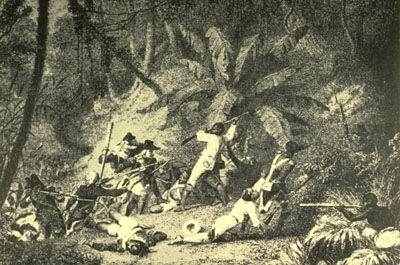January 8

Seven years after the United States acquired the massive Louisiana territory from France, the population of New Orleans consisted of more than 18,000 enslaved and free people of color who lived in subjection to the 8000 whites who also lived within the city walls. Louisiana was a horrific place for enslaved people, who died nearly as fast as they could be replaced, worn down by the building of levees, the clearing of fields, and the tending of sugar cane. Inspired by Haiti's recent successes against the Napoleonic armies, the slaves who lived in southern Louisiana's rural parishes hoped that a sudden insurrection -- assisted by the black majority of New Orleans -- might wrest control of the city away from its white minority. Like all slave uprisings in North America, previous ventures along these lines -- most recently in 1795 in Pointe Coupe -- had been brutally crushed and the conspirators executed swiftly. However, with US forces preoccupied with the Spanish in Florida at the time, the winter of 1811 seemed a more auspicious moment than most to revive the dream of a tiny black republic at the mouth of the Mississippi River.
After concocting their plot in the swamplands near Maupe, the rough militia embarked from the Aubry plantation, nearly 40 miles from the city, late in the afternoon of Janaury 8. They were led by a man named Charles Deslandes, who organized the army into neat formations and marched them with flags aloft. As their ranks swelled to more than 500 men armed with small arms and farm tools, the rebels arrived the next morning at the home of Jean Francois Trepagnier, six miles away. There, one of Trepagnier's slaves -- a young man named Gustav who had escaped shortly after his 21st birthday -- hacked his former master to death.
As word of the revolt spread throughout the sugar plantations, whites raised a militia of their own and were quickly assisted by US troops from Baton Rouge as well as the Free Black Militia of New Orleans, whose offers to help quell the insurgency were accepted. The enslaved rebels failed to reach the city arsenal, leaving them at the mercy of the much more capably armed free soldiers, who slaughtered them with canon fire at the Fortier Sugar Works, 18 miles from their' destination. Those who were not killed in battle were quickly tried and executed by hanging or firing squad at Saint Louis Cathedral. In the customary fashion, the heads of the slaves were cut off and placed along major roads as a warning to others.
Later, the Trepagnier plantation was renamed "Diamond." Today Diamond remains a predominantly black community, where descendants of slaves reside nearly 200 years after their ancestors witnessed the largest revolt in North American history.
By the end of the 20th century, Diamond had become a toxic swamp, as pollutants from incinerators, petrochemical and cement plants left the town's poorest residents suffering from chronic health problems.